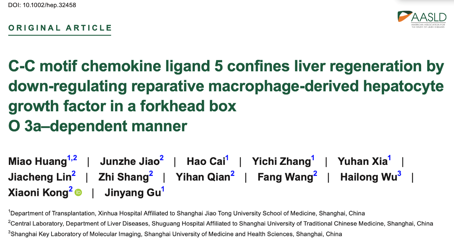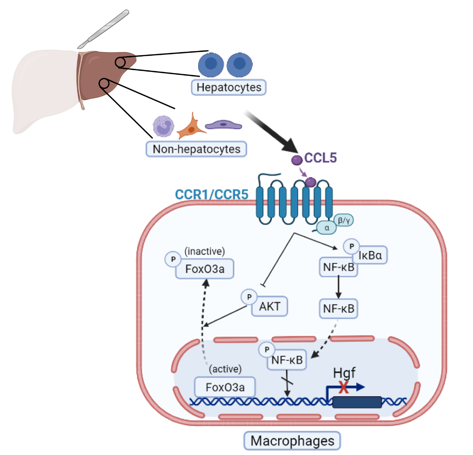Liver regeneration is vital to restoration of liver function after hepatectomy. Insufficient regeneration ability and insufficient volume of residual liver are the risk factors for liver failure after hepatectomy. Though inflammation plays a vital role in controlling liver regeneration, its underlying mechanism remains currently unclear.

Recently, Gu Jinyang, director of transplantation department of the Xin Hua Hospital affiliated to SJTUSM and Professor Kong Xioni with the Shuguang Hospital affiliated to Shanghai Chinese Medicine University, as co-corresponding author, publish online in the journal “Hepatology(IF=17.425)”a research paper titled “C-C motif chemokine ligand 5 confines liver regeneration by down-regulating reparative macrophage-derived hepatocyte growth factor in a forkhead boxO 3a–dependent manner”.
This research determines CCL5 as an important negative regulator to liver regeneration. In health donor for living donor liver transplantation and mouse model with partial hepatectomy (HPx), there is apparent rise of CC15 level.CC15 knockout mouse exhibits improved survival after 90% of partial hepatectomy, and moreover exhibits strengthened liver regeneration 36 hours after 70% of partial hepatectomy. However, compared with wild type mice, the CC15-/- mouse exposed in vitro growth factor does not exhibit proliferation advantage in the primary cultured hepatocytes.
Analysis of flow cytometry shows that, after 70% of partial hepatectomy, there is notable increase in the proportion of Ly6Clo macrophages in CCL5-/- mice. The RNA sequencing shows that, as compared with WT mice, the sorted macrophages (CD11b+Ly6Clo&hi) exhibit strengthened expression of repair gene in CCL5−/-mice. From the perspective of the mechanism, CCL5 induced macrophages tend to promote inflammation phenotype, consequently inhibiting the production of hepatic growth factor (HGF) by approach of CCR1 and CCR5 mediated Fox03a.
At last, in the mouse PHx model, the blocking of CCL5 significantly improves the survival and promotes the liver regeneration.
The outcome suggests that, strengthening by means of FoxO3a the HGF secretion of macrophages is a prospective strategy for improving regenerative recovery, and may help lower the mortality from liver failure after hepatectomy.

Huang Miao, a 2019 postgraduate with transplantation department of Xin Hua Hospital affiliated to SJTUSM, Jiao Junzhe the 2020 doctoral candidate with Shuguang Hospital affiliated to Shanghai Chinese Medicine University, Doctor Cai Hao, Doctor Zhang Yichi, and Xia Yuhan, the 2020 postgraduate with transplantation department of SJTUSM’s affiliated Xin Hua Hospital are the co first authors of the research paper. The research project is under the support of the key project and general project program of the National Natural Science Foundation of China, key clinical project of the Shanghai’s 3-Year Action Plan for Promoting Municipal Hospital’s Clinical Skill and Innovation Ability, Shanghai Outstanding Youth Medical Talents, Shanghai Municipal Education Commission Plateau Clinical Clinical Medicine Grant.

